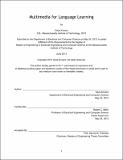| dc.contributor.advisor | Robert C. Miller. | en_US |
| dc.contributor.author | Kovács, Géza, M. Eng. Massachusetts Institute of Technology | en_US |
| dc.contributor.other | Massachusetts Institute of Technology. Department of Electrical Engineering and Computer Science. | en_US |
| dc.date.accessioned | 2014-03-05T15:55:46Z | |
| dc.date.available | 2014-03-05T15:55:46Z | |
| dc.date.copyright | 2013 | en_US |
| dc.date.issued | 2013 | en_US |
| dc.identifier.uri | http://hdl.handle.net/1721.1/85217 | |
| dc.description | Thesis: M. Eng., Massachusetts Institute of Technology, Department of Electrical Engineering and Computer Science, 2013. | en_US |
| dc.description | This electronic version was submitted by the student author. The certified thesis is available in the Institute Archives and Special Collections. | en_US |
| dc.description | Cataloged from student-submitted PDF version of thesis. | en_US |
| dc.description | Includes bibliographical references (pages 79-81). | en_US |
| dc.description.abstract | Students studying foreign languages often wish to enjoy authentic foreign-language content - for example, foreign-language videos and comics. Existing means of presenting this content, however, are suboptimal from the perspective of language learning. We have developed a pair of tools that aim to help learners acquire the foreign language while enjoying authentic, foreign-language material. One tool is Smart Subtitles, which help learners learn vocabulary while watching videos. Our user evaluations have shown that Smart Subtitles help learners learn vocabulary more effectively than a popular approach for learning from video (dual subtitles). The other tool is a grammar visualization which illustrates the grammatical structure of sentences. This grammar visualization can be embedded into a number of language-learning applications. This includes a foreign-language manga reader we have built, which aims to help learners learn vocabulary, grammar and pronunciation while reading comics and manga. Our study for the grammar visualization shows that it helps monolinguals arrive at more accurate translations if we have an oracle taking the best translation of all, though there was no significant improvement in the average translation quality. | en_US |
| dc.description.statementofresponsibility | by Geza Kovacs. | en_US |
| dc.format.extent | 92 pages | en_US |
| dc.language.iso | eng | en_US |
| dc.publisher | Massachusetts Institute of Technology | en_US |
| dc.rights | M.I.T. theses are protected by copyright. They may be viewed from this source for any purpose, but reproduction or distribution in any format is prohibited without written permission. See provided URL for inquiries about permission. | en_US |
| dc.rights.uri | http://dspace.mit.edu/handle/1721.1/7582 | en_US |
| dc.subject | Electrical Engineering and Computer Science. | en_US |
| dc.title | Multimedia for language learning | en_US |
| dc.type | Thesis | en_US |
| dc.description.degree | M. Eng. | en_US |
| dc.contributor.department | Massachusetts Institute of Technology. Department of Electrical Engineering and Computer Science | |
| dc.identifier.oclc | 870677869 | en_US |
